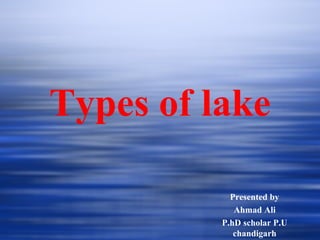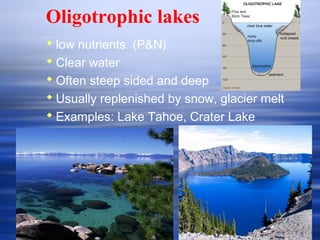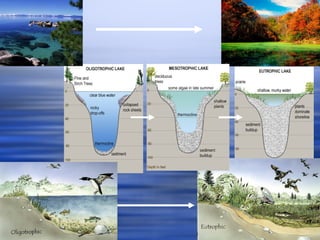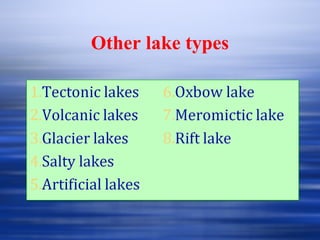Types of lake
- 1. Types of lake Presented by Ahmad Ali P.hD scholar P.U chandigarh
- 2. Lake A depression on the surface of the earth, where water gets collected . known as a lake.
- 3. Where does each lake type fall on the line? Low nutrients Very high nutrients
- 4. Lake types ï·On the basis of its tropic status Trophy = nutrient (phosphorus and nitrogen ) 1.Oligotrophic. 2.Mesotrophic. 3.Eutrophic.
- 5. ï· low nutrients (P&N) ï· Clear water ï· Often steep sided and deep ï· Usually replenished by snow, glacier melt ï· Examples: Lake Tahoe, Crater Lake Oligotrophic lakes
- 6. Mesotrophic lakes ï· Meso = middle or mid ï· Great fishing lakes ï· Stratification
- 7. Eutrophic lakes ï· High nutrient levels ï· Murky, green water ï· Usually shallow. ï· Usually replenished by rivers/streams
- 9. Cultural Eutrophication ï· We artificially cause lakes to become eutrophic by ï· Runoff ï· Pollutants ï· Thermal pollution ï· Lakes become hypereutrophic
- 10. Other lake types
- 11. Tectonic lakes Ex. Lake Baikal
- 12. Volcanic lakeVolcanic lake Associated with volcanic activity Form when the shut off volcano will be filled with water Associated with volcanic activity Form when the shut off volcano will be filled with water
- 13. Glacier LakesGlacier Lakes Formed when the surface is scoured, deepened and widened by the glacier. And the surface will be filled by glacier melt water Formed when the surface is scoured, deepened and widened by the glacier. And the surface will be filled by glacier melt water
- 14. Salty LakesSalty Lakes ïąCause by the limited supply of freshwater ïąTendency to concentrate the water with minerals ïąCause by the limited supply of freshwater ïąTendency to concentrate the water with minerals
- 15. Artificial LakesArtificial Lakes ïąManmade lakes ïąFor water reservoirs, electricity generation, etc. ïąManmade lakes ïąFor water reservoirs, electricity generation, etc.
- 16. Oxbow lake
- 17. Meromictic lake ï· Layer of water which don't intermix
- 18. Rift valley lake
- 19. Thank you



















